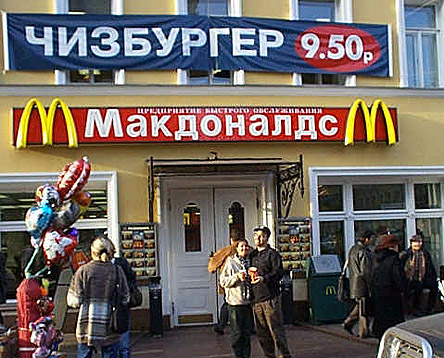 McDonald's in Moscow. Is there a better symbol of the "pop"ification of the world?  Write a two-page paper on the "pop"ification of world culture (double-spaced, one-inch margins, font size 10 or 12). Your paper topic must be pre-approved by your instructor. Your paper should have a short introduction (three lines max), followed by short background (4 lines max), then your analysis of the main points of that pop culture spread, and then a quick conclusion. Choose a single pop/cultural global phenomenon and explain its origins, development and impact. Be sure to cite your sources, and you should have a lot of sources and quoted material. Your selection can be from any decade since the end of World War II, such as the 1950s (Elvis Presley), 1960s (hippiedom), 1970s (Coke), 1980s (McDonald's), 1990s (NBA basketball), 2000s (blogs). Your selection can be from different areas such as art (Andy Warhol), food (Pepsi), music (The Beatles), fashion (blue jeans), film (Star Wars), literature (Harry Potter). These are just some examples, and here are some others that I could think of quickly: the web, junk food, television, MTV, ESPN, Apple (computer, smartphones, etc), cell phones, Starbucks, Barbie, video games, cyberculture, the English language. Always, check with your instructor first about your topic to make sure that it is ok. Now, what do I mean by the "pop"ification of world culture. This "pop"ification of the world is often couched in terms of "the Americanization of the world," or the transfer of elements of American culture to other cultures around the world, in the process usually displacing aspects of the native culture. For example, McDonald's restaurants put out of business local, family-owned eateries. In other words, everyone around the world ends up participating in the same cultural environment; the same food, the same language, the same fashion, the same movies, etc. But remember, that this is not usually a conscious process carried out by any large country--it does not have to originate in the US and the process can work also from small culture to large. For example, the United States government does not go around the world distributing blue jeans everywhere so that everyone can wear blue jeans. Everyone ends up wearing blue jeans for other reasons. In more academic circles, this process is often called cultural imperialism, and there are many resources on the web that discuss aspects, both good and bad, of cultural imperialism. You can also read my draft lecture notes on Pop Culture. Finally, I have a good example of a pop culture written by one of my students in the fall of 2009. In some rare occasions, I will accept a project that is not a paper, such as this timeline on Walt Disney by Mayara Alwan (2016), or this timeline by Xiomarys Santiago, former HIS 112 student, Top Ten Songs Related to War. Please consult Charlie's History Writing Center for specific information on the writing requirements of this course. The Pop Culture paper is worth either 50 or 100 points, depending on the course. |